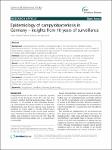Epidemiology of campylobacteriosis in Germany – insights from 10 years of surveillance
Schielke, Anika
Rosner, Bettina
Stark, Klaus
Background: Campylobacteriosis caused by Campylobacter spp. is the most common notifiable bacterial gastrointestinal disease in Germany and a major problem in many other European countries as well. In contrast to other infectious diseases, e.g., salmonellosis, the annual number of notified campylobacteriosis cases has increased in Germany and other European countries from 2001–2010. Methods: National surveillance data from 2001 through 2010 were the basis of a detailed description of the epidemiological pattern of Campylobacter infections in Germany. Special focus was placed on geographical distribution and time trends of Campylobacter infections as well as the identification of risk groups. Results: In total, 588,308 cases of campylobacteriosis were recorded during the observed time period. The mean annual incidence increased from 67 cases/100,000 population in 2001 to 80/100,000 population in 2010. Almost 92% of the notified Campylobacter infections were acquired in Germany. A seasonal distribution was observed with a large peak in the summer months and a small peak in January. Incidence was highest in children ≤4 years and young adults 20–29 years of age. Especially young children living in rural regions in Germany seemed to be at high risk of Campylobacter infection. Conclusions: Campylobacter is the leading cause of bacterial gastroenteritis in Germany, and has been of rising public health concern. There is a need for enhanced prevention of Campylobacter infections and the data presented here may contribute to better target prevention measures with focus on identified risk groups such as children and young adults.
No license information

